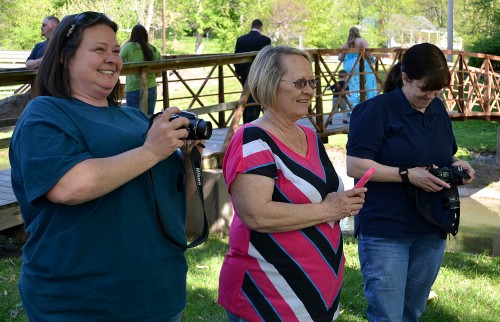 Mother and I were on our way to Wib’s in Jackson for my last BBQ before leaving Missouri. On the way past Jackson’s city park, a flash of glow-in-the-dark green and a small crowd caught our eye. I did a U-turn (causing Mother to gasp uncharacteristically when she thought I turned too quickly in front of an oncoming car) and headed into the park.
Mother and I were on our way to Wib’s in Jackson for my last BBQ before leaving Missouri. On the way past Jackson’s city park, a flash of glow-in-the-dark green and a small crowd caught our eye. I did a U-turn (causing Mother to gasp uncharacteristically when she thought I turned too quickly in front of an oncoming car) and headed into the park.
We drove around spotting other gaggles of kids in fancy clothes and even a horse-drawn carriage. Pulling up to the Green Gal gaggle, I rolled down the window and asked, “Wedding or prom?”
It was the Jackson High School prom.
The Green Gal Gaggle
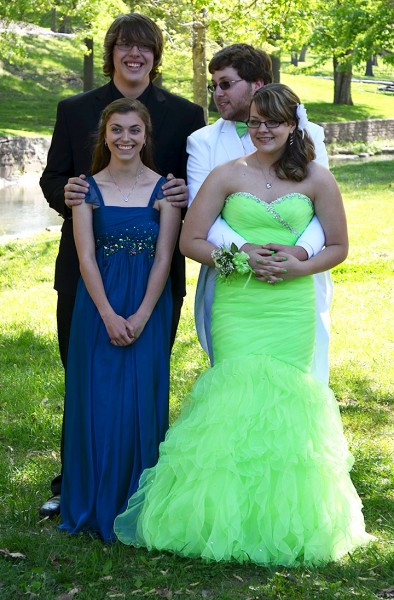 The foursome provided names: Tessa Long and Amanda Matlock are in the front row, left to right, and their dates are Mitchell Graham and Alex Wright.
The foursome provided names: Tessa Long and Amanda Matlock are in the front row, left to right, and their dates are Mitchell Graham and Alex Wright.
[Editor’s note: When I asked if was a wedding or a prom and was told “prom,” I joked, “Well, since you are all dressed up anyway, why don’t you go ahead and get married?” I got a call this morning that I must have had that on my mind when I was typing at 2 in the morning, because in the first posting of the story, I called Amanda Matlock “Amanda Wright.” I guess I was determined to marry her off. I have officially annulled her marriage and given her back her maiden name. Another note: the kids were home by 1 a.m. The prom ended at 11 and the stopped at Denny’s on the way home. I guess the younger Jackson generation doesn’t have the stamina that the Cape Central Class of ’65 had: our party lasted all night.]
Color coordination
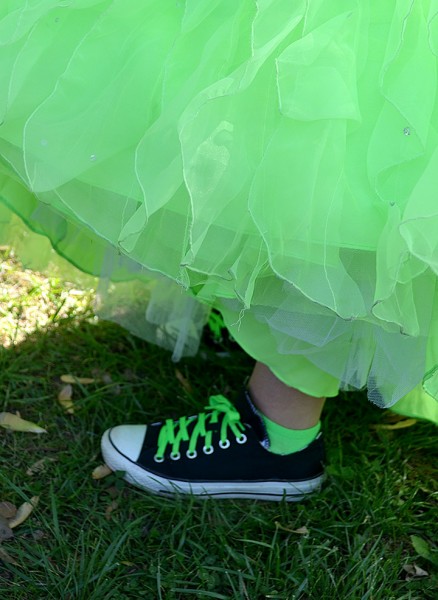 Alex’s tie matches Amanda’s dress, but Amanda went him one better with her green socks and shoelaces. This is a gal who looks like she’s ready for some serious dancing.
Alex’s tie matches Amanda’s dress, but Amanda went him one better with her green socks and shoelaces. This is a gal who looks like she’s ready for some serious dancing.
Our May 4th memories will be different
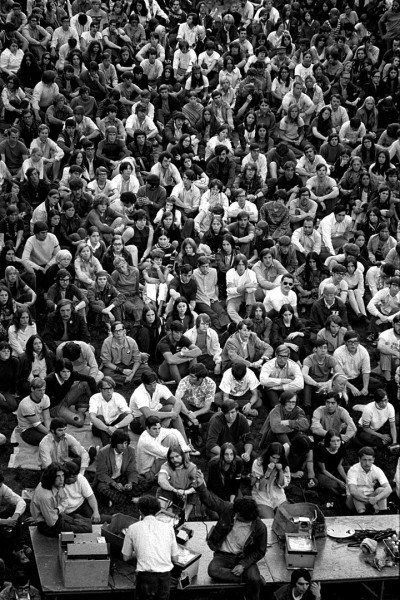 When Tessa, Mitchell, Alex and Amanda wake up on May 4, their memories of that date are going to different than mine. They are going to remember the clothes, dancing, music and fun.
When Tessa, Mitchell, Alex and Amanda wake up on May 4, their memories of that date are going to different than mine. They are going to remember the clothes, dancing, music and fun.
I’m going to remember four Kent State students who were gunned down by the Ohio National Guard on May 4, 1970. Former Palm Beach Post chief photographer John J. Lopinot sends me an email every year: “Never Forget.” I don’t intend to.
Another photographer and I were on our way to Marietta, Ohio, to a surplus store where we were going to pick up riot gear and head up to Kent State. We were about half-way there when a radio news bulletin reported the shootings, although the initial garbled reports had the guardsman as being the ones shot. We elected to get the gear and head back to Athens and Ohio University, because we didn’t know how our campus was going to react.
4,000 gathered on College Green
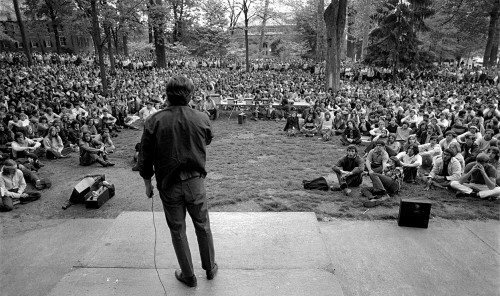 The protest movement up until that point was fairly small and made up of “radical” students. That afternoon and evening, though, as many as 4,000 students, professors, townspeople, preachers and even a congressional candidate crowded onto the College Green to listen to speeches and to figure out what was going to happen next.
The protest movement up until that point was fairly small and made up of “radical” students. That afternoon and evening, though, as many as 4,000 students, professors, townspeople, preachers and even a congressional candidate crowded onto the College Green to listen to speeches and to figure out what was going to happen next.
The most moving moment was when a young woman who said she was a Kent State student came out of the darkness and grabbed the microphone. She said she and some of her friends had witnessed the shootings and had agreed to fan out to the other state schools to beg the students not to allow a similar bloody confrontation to happen.
“The kids at Kent are running scared,” she was quoted by Tom Price in The Athens Messenger. “Don’t bring that here. Don’t throw rocks here. You don’t know how good it is to be here tonight. Just stay this way, please. Keep cool and stay together, please – male and female – because there have been two girls killed and two guys.”
Ministers call for 24-hour memorial fast
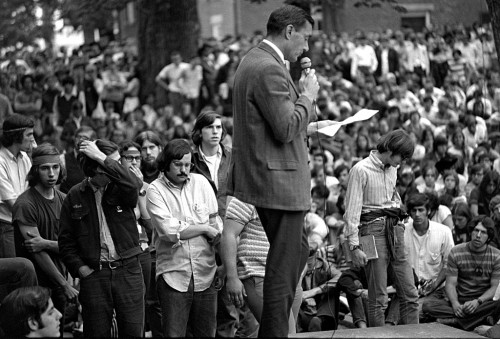 After the young woman spoke, Rabbi Joseph Polak called for prayer, and silence fell over the 4,000 persons on the green. Each minister then offered his own short prayer.
After the young woman spoke, Rabbi Joseph Polak called for prayer, and silence fell over the 4,000 persons on the green. Each minister then offered his own short prayer.
“I’m calling you to prayer for your brothers and sisters at Kent,” the Rev. Thomas Niccolls said. “I’m calling you to prayer for your brothers and sisters in Vietnam. I’m calling you to prayer for your brothers and sisters in Cambodia.”
“As we pray for the dead and the dying,” the Rev. Robert Hughes said, “let us pray for the living and for ourselves. We have seen enough dying and enough pain for a lifetime.”
The Rev. Thomas Jackson concluded the prayer
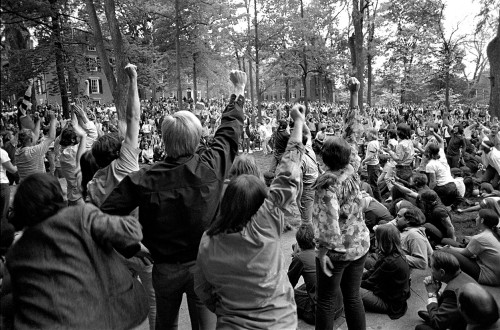 “I’ve gotta try one more time. I just want a moratorium for one day on the terms ‘jock’ and ‘Greek’ and ‘hippie’ and all the things we use to punch each other out.”
“I’ve gotta try one more time. I just want a moratorium for one day on the terms ‘jock’ and ‘Greek’ and ‘hippie’ and all the things we use to punch each other out.”
Praying the students realize what it’s like when people who are shot and killed, the Rev. Thomas Jackson quoted a Kent State student who said he thought the National Guardsmen were firing blanks, “until I saw her head blown open.”
“It’s time to quit blowing open heads,” the Rev. Jackson said. “It’s time to quit splitting up and hating and disgusting each other. Can’t we just once do it? Just one day, that’s all I ask. Please remember that head that was blown open. Do something embarrassing tonight. Like don’t kill each other. Like touch someone. Be a fool.”
A lengthy standing ovation from the demonstrators followed Jackson’s prayer.
OU Closed on May 15
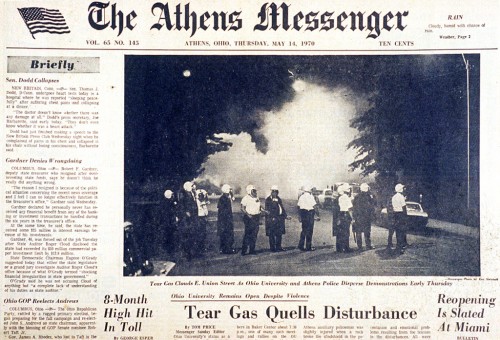 Ohio University managed to stay open until May 15, when it closed after two nights of tear gas and rioting.
Ohio University managed to stay open until May 15, when it closed after two nights of tear gas and rioting.

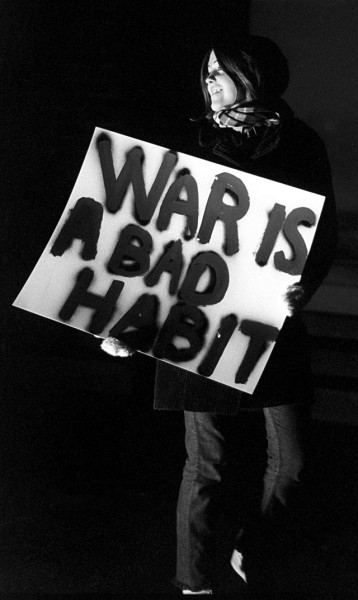
Thanks for reminding me to never forget. The photo of the girl kneeling beside the dead student on the ground was forever etched in my memory at the young age of 14.
I often wonder what would be the fallout if something like this happened now. School violence is practically commonplace these days; as I scan the breaking news ticker, I see daily mention of ‘bomb threat’ and ‘gunman on campus’. Would ‘Four Dead in Ohio’ still make front page above the fold? Would the Guard be lauded as heroes, or condemned as killers? Would the students’ reputations be dragged through the mud, as they were during the summer of 1970? Would adults still say “they should have killed more”? Would today’s students be outraged, launching protests on their own campuses, or would they simply retweet the story and move on?
On 5/04/70 I was somewhere in Cambodia following our CinC orders to eradcate our adversary. It did not sit well with me when I learned of the violence at Kent State over our involvement in SE Asia – I for one felt contempt for the ‘students’ actions as being unpatriotic and the results were of their own choosing.
Wally, I guess I’ll start off with the obligatory “thank you for your service,” before addressing your comment. You certainly earned your right to an opinion, but the First Amendment also guaranteed the students their right to protest. If they were doing something illegal, then they should have been arrested, not executed.
1. Maybe if Commander in Chiefs Eisenhower, Kennedy, Johnson and Nixon hadn’t gotten us into that war, then maybe you wouldn’t have been in Cambodia on May 4, 1970. History has shown that the protesters were more right than the politicians who got us into the war and kept us there.
The Gulf of Tonkin Resolution which provided cover for the escalation of the war in 1964 was based on an attack which never occurred. Even Lyndon Johnson admitted privately in 1965, “For all I know, our Navy was shooting at whales out there.”
Robert McNamara, one of the architects of the war, wrote just before he died, “We of the Kennedy and Johnson administrations who participated in the decisions on Vietnam acted according to what we thought were the principles and traditions of this nation. We made our decisions in light of those values. Yet we were wrong, terribly wrong. We owe it to future generations to explain why.”
History, it would appear, is on the side of those who opposed the war, not the side of those who started and continued it.
2. Have you looked at the investigations done on the Kent State shooting?
The FBI reported that 28 guardsmen acknowledged firing from Blanket Hill. The three ranking officers said no order to fire was given, by the way. Of the 28, 25 fired 55 shots from rifles; two fired five shots from .45 caliber pistols and one fired a single blast from a shotgun.
The closest two victims suffered wounds to the right abdomen, lower leg and left ankle. They were 20 yards – 60 feet – from the firing line.
The closest of the four fatalities, Jeffrey Miller, was 85 to 90 yards from the firing line. Allison Krause was 110 yards away. William Schroeder and Sandra Scheuer were 130 yards away. Scheuer, by the way, was believed to have been on her way to a 1:10 p.m. class in the Music and Speech building when she was shot. She has not been identified in any photographs as having attended the prohibited rally on campus.
One student who survived with a wound in the left rear of his neck, Donald Mackenzie, was 245 to 250 yards – 750 feet – away from the firing line.
I’d like to know how someone 2.5 times the length of a football field away from the firing line constituted a threat worth deadly force.
4. The Scranton Commission, also known as the President’s Commission on Campus Unrest, came to the conclusion “The indiscriminate firing of rifles into a crowd of students and the deaths that followed were unnecessary, unwarranted, and inexcusable. Even if the guardsmen faced danger, it was not a danger that called for lethal force.”
Maybe the outcome would have been different if the students had been exercising their Second Amendment rights that some of our “patriots” are so fond of.
McNamara’s remarkable admission of the terrible decisions that resulted from their mis-interpretation of the goals of communism in SE Asia are chronicled in a DVD titled “The Fog of War”. My job entails a constant investigation into how people make decisions and how they came to be in the decision making position in the first place. Regardless of your position on the rightness or wrongness of the Kent state shootings, “The Fog of War” $9.00 on Amazon, will give you revelations into the backdrop of the event that are extraordinary. I could see that 50,000 dead American youth had weighed heavily on McNamara through the years, as it should have. But for him to share the struggles that he went through coming to grips with how he could have sacrificed so many souls on both sides while believing a falsehood that existed only between his two ears and a few others in the Johnson administration, is what makes the DVD a must for those of us who lived through it. I came away feeling that it was a gift from McNamara to future generations.
The fact that the guardsmen were never charged with murder is what happens when your side is in power. Not unlike congress members being immune from insider trading activities.
I see Wally Sinnwell touched your hot button Ken as I did some months ago about Kent State. There is an old saying that you don’t wish for something too hard or you just might get it. The students that day at Kent State were looking for trouble and they got it. I am not saying anyone deserved to be killed, but the National Guard were not there as ushers. Blame Johnson and Kennedy for starting the war, and thank Nixon for getting us out. The logistics you quote were Monday morning quaterbacking. At KS you had scores of students throwing rocks, bottles and whatever they could at the National Guard, who were there to protect those protesting idiots from themselves and destroying Kent State University property. You and others who think like you never addressed the fact the students were trying to hurt the soldiers. The soldiers didn’t have rights to be safe while on duty? I’m sure if you had asked them they didn’t want to be there. The KS students protestors were like all the other protestors across the country, they wanted to run rampant destroying what they could with impunity. At KS, they hit a wall. As for your slam on the second amendment, would you prefer the National Guard show up at a potential riot with pop guns? The ones that shoot corks? How about just show up unarmed? That would have worked, for the protestors and their rocks a bottles. It was a tragedy, but one of their own making.
Yeah, Tim, you and I plowed this ground before, so anybody who cares can go back to some of the earlier posted links.
Rather than rehash the guard’s role in killing or wounding unarmed students who were anywhere from 2/3 of a football field to nearly 3 times the length of a football field away from them (most of were not actively participating in the protest and some who were merely walking to class), I’ll take issue with your statement that Nixon ended the war.
Yes, he may have made the decision to pull the troops out, but he did it unwillingly and only because the protests finally were successful in making the war unpopular. Even Lyndon Johnson realized the tide had turned when he said, “If I’ve lost Cronkite, I’ve lost Middle America.”
This collection of quotes from Nixon doesn’t make Dick sound like like a peacemaker:
“I’m not going to be the first American president to lose a war.” —President Richard Nixon in October 1969, six years before the Vietnam War finally ended
Nixon: I still think we ought to take the North Vietnamese dikes out now. Will that drown people?
Kissinger: About two hundred thousand people.
Nixon: No, no, no, I’d rather use the nuclear bomb. Have you got that, Henry?
Kissinger: That, I think, would just be too much.
Nixon: The nuclear bomb, does that bother you?. I just want you to think big, Henry, for Christsakes.
[In conversation with Henry Kissinger regarding Vietnam, as quoted in Secrets: A Memoir of Vietnam and the Pentagon Papers. (2002)]
Nixon: The only place where you and I disagree is with regard to the bombing. You’re so goddamned concerned about civilians and I don’t give a damn. I don’t care.
Kissinger: I’m concerned about the civilians because I don’t want the world to be mobilized against you as a butcher.
If you don’t think Nixon, Agnew and Ohio Gov. Rhodes didn’t give the guard tacit approval to fire on students, look at this Nixon quote from Wounded Knee days:
“I think we ought to move tanks, the whole goddamned thing. Put a division in there, if necessary, It’s time for action on it. If some Indians get shot, that’s too goddamned bad. If some Americans get shot, that’s too bad, too.”
[President Richard Nixon on the standoff at Wounded Knee with Native American militants]
I agree to disagree. I’m no historian but 45 years ago we were in a very real war with a very real nuclear threat from Russia and/or China and Nixon inherited that mess. I bet there were a lot things Kissinger and Nixon broached and scenarios they kicked around that weren’t recorded. As the President, I don’t think you can care about civilian casualties if you are willing to use nuclear weapons. Let us not forget, Nixon and Kissinger were all talk about the use of nuclear bombs, but Truman did the deed. What do you think he and his advisory staff said before he made the decision to drop the big one(s)?
In reading your reply Ken, I guess you are one of those individuals who can claim canadian citizenship due to their failure to ebrace our form of government which allows for ‘peacefull’ demonstrations and not one of violence. If you have never experienced the rush of adrenaline when you are confronted by someone threating your life and do believe a person can stop and reflect on all the platitudes you mentioned. I guess in your minds eye, George Washington and Abrahan Lincoln should be vilified for all the ‘deaths’ which occurred due to their reactions in our war of independence and the civil war. I bet your champion is the former Prime Minister of England Neville Chamberlain – the ‘original’ beatnik or ‘hippie’ who did not have the moral courage to defend his country or his countrys’ allies against Hitler and Mussolini. I guess your axiom in life is ‘let George do it, I don’t want to get my hands dirty’.
Wally and Tim, I guess you guys get nearly the last word. I’m pulling the plug on the computer equipment to pack it up for a journey from MO to OH back to FL.
Your hero George Washington, you might recall, led an armed insurrection against the King of England. I think some violence took place during that encounter. Do you say that violence against an organized government is never justified?
I also note that the NRA and Ronald Reagan supported the Mulford Act in 1967. That was a California bill prohibiting the public carrying of loaded firearms. Named after Republican assemblyman Don Mulford, the bill garnered national attention after the Black Panthers openly carrying weapons (which was legal) peacefully marched on the California Capitol to protest the bill. The bill was signed by Republican California Governor Ronald Reagan. Sounds like the Second Amendment comes color-coded.
It is pretty apparent from reading the after-action reports that Ohio’s official “well-trained” militia must not have been all that well-trained, since no officer claimed to have given the order to fire. They also must have been lousy shots because they didn’t pick off anybody close enough to throw a strike from a pitcher’s mound. All the collateral damage was well outside the ballpark.
Jumping over to Tim’s comment about nukes, Truman was in a different scenario: Japan attacked us and we were going to take enormous casualties if we had to fight the Japanese island to island to the bitter end. I don’t envy Truman’s having to make that decision, particularly under the circumstances that put him into the Big Seat. All things, considered, I’m betting that the decision to drop the bombs was as much to send a message to the Russians as it was to win the war in Japan.
I don’t recall anyone from Vietnam bombing Pearl Harbor. And, as far as the domino theory about what would happen if we lost in SE Asia, I picked up something in a store the other day that said “Made in Vietnam,” and I’ve had friends tour there who said they were welcomed. What, exactly, did we get in exchange for 58,209 dead soldiers, 153,303 wounded and 1,643 MIAs?
OK guys, we can pick this up on the next anniversary. I have to get on the road.
Boys, boys!!! I was number 20 in the first lottery. Yes I went and Leonardwood became my new home for a while. To come to some sort of considered position on those days of our youth gone by, try putting yourself in the mind frame of both the antiwar protesters and those of us who answered the call and did our duty. There were transgressions on both sides.
THE PROTESTERS; violated the law and destroyed public, “university”, property and acted in unorthodox ways. Their total toll was figured by accountants and insurance companies who had to tabulate and pay for the repairs.
THE GOVERNMENT; had to find ways to spin a non-event in the Gulf of Tonkin to justify a ramping up of US military personnel that resulted in 58,000 dead US kids and untold 100s of thousands dead Vietnamese. Plus they spent Billions of our tax dollars in the prosecution of the war.
THE POLICE; When we rile against the obnoxious Protesters who were exercising their 1st amendment rights by saying things that seemed to be anti-American we must also apply the same patriotic measuring stick to the “police riot” at the Democratic convention in “68”.
We’ve lived a life since those days. We should be able to see through the lens of history and measure the weight of the transgressions on all sides and realize who carried the most correct moral compass.
Mike, nice, balanced look at history. One of the few nits I’d pick is that some, if not most, of the students were not threats to the National Guardsman based on the distance from where the shots were fired. A kid walking to class shouldn’t be collateral damage because some guy with a gun panics and starts firing indiscriminately.
To those who say the blood of the innocent should fall on the protesters, I’d say the blood of the innocent should be charged against those in government who blundered us into a was against a region that posed no direct threat to the U.S.
I would say the same about our latest incursion into the Mideast. The difference is that the war in Iraq wouldn’t have lasted a decade if our sons and daughters were being drafted. The streets would have been full of people calling for an end to the war, just like in the ’60s a d ’70s..